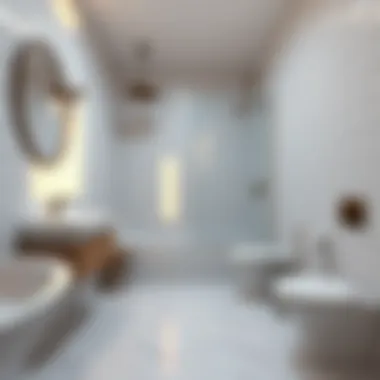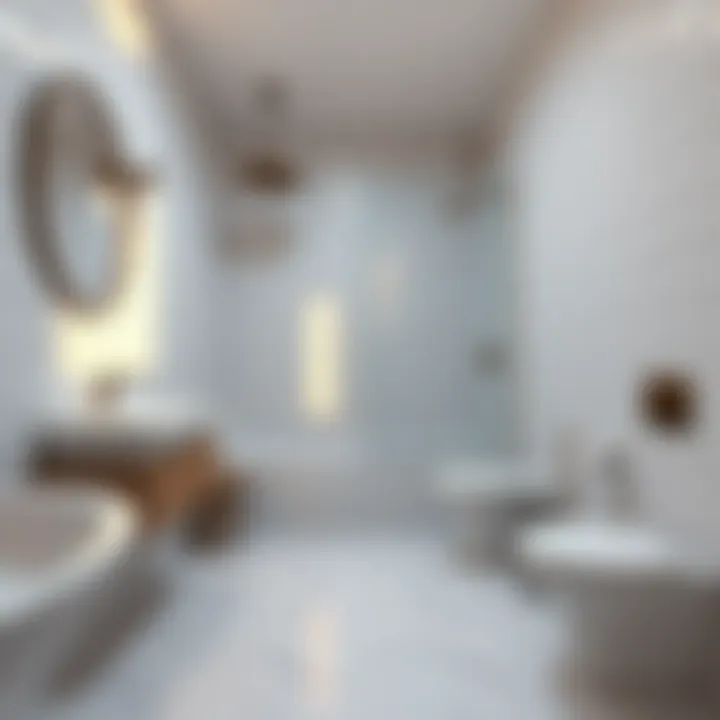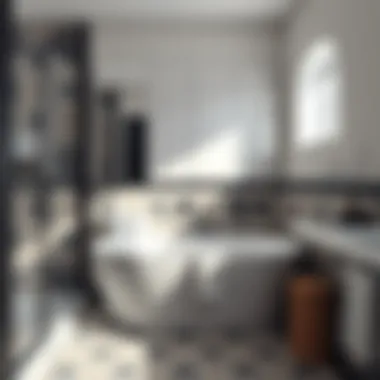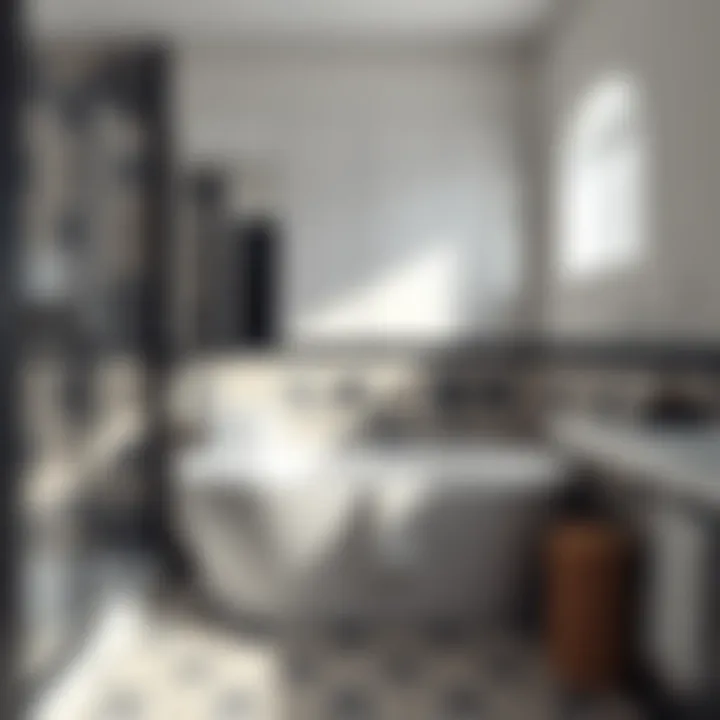Stylish Floor Tile Ideas for Compact Bathrooms


Intro
Small bathrooms often present a unique set of challenges. Homeowners are constantly grappling with how to make the best use of limited space while ensuring both style and functionality coexist. When it comes to flooring, the choice of tiles can profoundly influence the overall ambiance and usability of the space. Hence, selecting the right tile design becomes a crucial decision.
This article serves as a guide to navigate through the myriad options available, highlighting design inspirations, trending styles, color palettes, and practical considerations unique to smaller bathrooms. With the right insights, transforming your compact sanctuary into a functional and aesthetically pleasing retreat is well within reach.
Design Inspirations
Trending Styles
When thinking about tile designs for small bathrooms, it's imperative to pay attention to the prevailing styles that resonate with modern trends. One of the most noticeable shifts in recent years is the emphasis on minimalism. Sleek, simple lines and subtle textures tend to create a sense of space, thus giving the illusion of a larger area. Subway tiles, for example, have made a triumphant return, often styled in various layouts such as herringbone or stacked, lending a fresh spin to classic designs.
Another style that has gained traction is the rustic look. Textured tiles that mimic natural materials, like wood or stone, offer warmth and character without overwhelming the space. The rich, earthy tones not only add personality but also help ground the overall aesthetic of the bathroom.
The geometric patterns have also become increasingly popular. While they hold a striking visual appeal, using such bold designs sparingly can maintain balance in a compact area. Should a full wall not be feasible, consider employing a patterned tile as an accent in smaller doses or even on the floor for added interest.
Color Palettes
Color plays a vital role in establishing the mood of your small bathroom. Lighter shades typically help create an airy atmosphere, making the space feel more open. Think soft whites, pale blues, or gentle grays. These hues not only reflect light but also provide a calming backdrop against which other elements can pop.
Alternatively, bold colors can be effectively employed if used wisely. A deep navy or charcoal can add drama and sophistication when combined with contrasting light fixtures or cabinetry. Make sure to balance darker colors with sufficient lighting to keep the space from feeling cramped.
When experimenting with patterns or textures, try to maintain a cohesive color scheme throughout. For instance, pairing olive green tiles with neutral accents fosters a soothing, nature-inspired retreat.
Key Takeaway: Choose tiles that not only enhance your bathroom's aesthetics but also complement the other design elements present. Balance is crucial in small spaces.
Product Recommendations
Bath Accessories
Once you've established your tile design, the next step is to choose bath accessories that harmonize with your chosen aesthetic. Consider materials that match your tiles' finish. If you're leaning towards the rustic vibe with textured tiles, wooden or bamboo accessories would blend seamlessly.
Conversely, if you favor a more sleek and modern look, opt for metal or glass accessories. The idea is to build on your base tile design while providing function and utility to your small bathroom.
Bedroom Essentials
Turning to functional yet fashionable elements, don't overlook the importance of textiles in your bathroom's design. Towels, shower curtains, and bath mats can introduce softness and add layers of comfort to the often harsher tile elements. A smart choice would be to pull colors from your tile palette.
In summary, both accessories and textiles can enhance the design and usability of your space effectively. The transformation of any small bathroom hinges upon thoughtful choices tailored to both aesthetic preferences and functionality.
Prelude to Floor Tile Designs
When we talk about transforming small bathrooms, the flooring often gets overlooked in favor of splashy vanities or elegant fixtures. However, understanding the importance of flooring can significantly shape the feel and functionality of a tiny space. The right tile can not only expand the visual perception of space but also set the tone for the overall aesthetic you wish to achieve. In a small bathroom, tiles serve a dual purpose; they safeguard against moisture while offering style.
Choosing quality tiles makes a substantial difference in durability, comfort, and design. They are your bathroom's first line of defense against drips and splashes, helping maintain a clean and stylish environment. A well-chosen floor tile option combines practicality with artistry, creating a hybrid of beauty and functionality that addresses both form and function.
This article dives into the essentials encompassing different tile options, color schemes, and textures appropriate for smaller settings. From trends to considerations, we’ll discuss how to craft a bathroom that reflects your personality and meets your daily needs.
Importance of Flooring in Small Bathrooms
With limited real estate, flooring becomes a critical element in small bathrooms. The right choice can visually enhance the space, lending it an air of openness and sophistication. Using light colors or specific patterns can create the illusion of space, while darker tones may make the room feel cozier but also tighter. Hence, it’s vital to select wisely, considering both ambiance and functionality.
In addition, tiles offer various benefits: they’re easy to clean, resistant to water, and come in numerous textures that can increase grip — essential for safety in wet areas. Floor tiles play a pivotal role in moisture control, combating the dampness common in bathrooms, ultimately prolonging their life span.
Trends Influencing Tile Choices
In today’s dynamic world, the trends in tile designs reflect broader cultural movements and environmental consciousness. Homeowners are now more than ever valuing aesthetics intertwined with sustainability and technology.
Sustainability in Flooring
Sustainability has morphed into a crucial aspect of flooring choices. Opting for eco-friendly tile options resonates well with the growing awareness about environmental impacts. Tiles made from recycled materials or sustainably sourced stones are increasingly in vogue, lending both beauty and responsibility to one’s bathroom. Such tiles not only significantly reduce overall waste but also positively influence indoor air quality, creating a healthier environment.
Moreover, these sustainable options, while current and stylish, often come with a unique facet — durability. Many of these materials are more resilient, ensuring they last long without the need for frequent replacements, which is a win-win for eco-conscious homeowners.
Technological Advances in Tile Design


Technology’s impact on the tile industry has been nothing short of revolutionary. Advanced manufacturing processes now allow for incredibly realistic prints, enabling ceramic or porcelain tiles to mimic natural stones and even wood. This aspect provides homeowners with a wider array of choices when designing their spaces without sacrificing style for practicality.
Furthermore, advancements in the production of tiles ensure properties like improved slip resistance and enhanced durability, which are particularly beneficial in moisture-prone bathrooms. This modern blend of style and safety offers a range of designs that cater to both aesthetic desires and functional needs, ultimately enhancing the bathroom experience.
"Flooring choices are more than just aesthetics; they shape the environment and function of your space, especially in the compact realms of small bathrooms."
Choosing the Right Tile Material
Choosing the right tile material is a cornerstone decision when it comes to crafting a small bathroom that is not only stylish but also practical. In confined spaces, every choice counts, influenced by various factors like maintenance, aesthetics, cost, and durability. The material you select will set the stage for the overall feel of the room and can either contribute to a cramped sensation or enhance the illusion of spaciousness. Therefore, understanding the unique qualities of each material can empower homeowners to make informed decisions that balance both form and function.
Ceramic Tiles
Ceramic tiles stand out as a popular option for bathrooms, particularly for small spaces. They are made from a blend of natural clay, sand, and water, which are then baked at high temperatures. One of their key advantages is versatility; they come in an array of colors, sizes, and textures, offering a near limitless selection. Furthermore, ceramic tiles are generally affordable, making them accessible for most homeowners.
However, one must also consider the potential downsides. While ceramic is fairly durable, it can crack under pressure, making it vital to install it correctly. For smaller bathrooms, larger patterned tiles may create the illusion of more space. Also, choosing a glazed finish can add to the shine, reflecting light and adding brightness to a space that might otherwise feel snug.
Porcelain Tiles
Porcelain tiles are an upgraded version of ceramic, produced from finer clays and fired at higher temperatures, which gives them enhanced durability and water resistance. If you’re in a region where moisture is a concern, porcelain may be the ideal choice as it is less porous than ceramic, making it less prone to stains.
When looking at aesthetics, porcelain tiles can mimic natural stone or wood quite convincingly, offering an array of stylish designs. This can allow homeowners to achieve that high-end feel without the high-end price tag associated with actual stone. Given their strength, they're suitable for floors and walls alike, providing flexibility in design. However, be mindful of the cost—porcelain tends to be a bit pricier than ceramic, but definitely worth the investment for longevity and maintenance ease.
Natural Stone Options
Natural stone tiles, such as granite, marble, or slate, bring a unique elegance to small bathrooms, turning an ordinary space into a luxurious retreat. Each stone's unique vein patterns and textures offer distinct looks that can’t be replicated in synthetic materials. Besides their aesthetic appeal, these materials are incredibly durable, resistant to wear, and generally improve your home’s value.
On the flip side, natural stones typically come with higher maintenance needs; they often require sealing to protect against moisture and staining. This could translate into added costs down the line. Additionally, they can be slippery when wet, so a textured finish is paramount if you want to prioritize safety.
Vinyl Tiles
Vinyl tiles are often perceived as a low-cost option in the realm of flooring, yet they have come a long way in terms of design and durability. They are quite popular among homeowners who seek low maintenance and high versatility. Available in sheets or as interlocking tiles, vinyl can mimic various high-end materials, allowing for creative flexibility.
One significant advantage is their resilience to water, making them a natural fit for bathrooms where moisture is unavoidable. Moreover, they are softer underfoot compared to ceramic or stone, which is a boon for anyone spending time standing for showers or grooming. However, quality can vary greatly, and avoiding the cheap versions is advisable to prevent premature wear and tear.
"Choosing the right material is like laying the foundation of your dreams. Each tile tells a story, creating a beautiful space you can call your own."
Relevant Resources:
- Wikipedia provides a broader understanding of tiles and their types.
- Britannica offers a historical perspective on tile usage through time.
- Reddit can be a helpful forum for homeowner experiences and questions.
Color Schemes and Patterns
Color schemes and patterns play a pivotal role in defining the ambiance and perception of space in small bathrooms. By wisely choosing the right colors and designs, one can enhance the visual appeal while also making the area feel larger. It’s well-known that color has the ability to influence mood and perception—designers leverage this to create harmonious and cohesive environments. In small bathrooms, the stakes are a bit higher, as these spaces tend to be more confined. Thus, understanding the interplay of colors and patterns is essential for optimizing both aesthetics and functionality.
Neutral Palettes to Enhance Space
Neutral palettes are often the go-to for small bathrooms, and for good reason. They create an inviting canvas that extends the perception of space. Shades such as beige, soft grey, and warm whites reflect light, contributing to a more open feel. Soft colors can help in making the features of the bathroom stand out without overwhelming the senses.
Benefits of using neutral palettes:
- Versatility: Neutral tiles can be easily paired with varying decor styles, from modern minimalism to vintage charm.
- Timelessness: You won't find yourself quickly wanting a change, as neutrals are classic and versatile.
- Ease of Accents: They allow for easy incorporation of colorful pieces like towels or ceramics, giving you a chance to add a splash of character.
A soft grey tile can evoke calmness while expanding a cozy space. Using subtle textures in the tile can add depth without drawing attention away from the overall serene atmosphere of the bathroom.
Bold Colors for Statement Floors
If you're the type who aims to break the mold and make a statement, then vibrant colors may be your best friend. Bold hues, such as deep blues, radiant reds, or sunny yellows, can inject personality into a small space.
Such colors can serve as a focal point, drawing the eye and steering attention away from other elements that may not be as visually appealing. The trick is to balance the use of bold colors with the overall decor. Use these shades to highlight certain areas, like around the bathtub or sink, rather than covering all surfaces.
Considerations for bold choices:
- Intensity & Balance: Too much saturation can create a claustrophobic feeling; opt to paint one wall or use bold tiles as accents only.
- Compatibility with Fixtures: Ensure your fixtures harmonize with these colors. A bright orange tile might clash with a soft pastel theme.
- Mood Setting: Bold colors can energize the space but keep an eye on your choice—what feels energizing to some may seem overwhelming to others.
Geometric Patterns for Visual Interest


Geometric patterns can be exciting yet daunting in small bathrooms. They offer a striking way to introduce unique designs without overwhelming the space. From hexagons to chevrons, the patterns bring an element of surprise that can turn an ordinary floor into a conversation starter.
Using geometric tiles can guide the eye across the floor, making the area appear more dynamic and larger than it is. A herringbone pattern, for instance, not only adds texture but can trick the mind into thinking the space is more expansive due to its lines.
Key tips when using geometric patterns:
- Scale Matters: Larger patterns can dominate smaller spaces, whereas smaller, intricate designs can engage without overpowering.
- Mix it Up: Pair geometric patterns with solid tiles to avoid visual chaos. A patterned border surrounding a solid tile area can provide structure.
- Color Coordination: Ensure that the color palette of the patterns complements the overall scheme of the bathroom.
Tile Size and Format Considerations
When tackling the challenge of designing a small bathroom, the size and format of the tiles you choose are going to play a pivotal role. This aspect isn’t just about aesthetics; it's about how the flow of the space feels and functions. Fitting larger tiles seamlessly can create an illusion of more space, while smaller tiles can add texture and intricate details to a confined area. Understanding the nuances of these choices will help you effectively enhance the overall experience of your bathroom, making it a delightful retreat.
Large Format Tiles for Extended Visuals
Larger tiles have taken the design world by storm and for good reason. They typically measure 12x24 inches or larger, which allows for fewer grout lines, making a room look less cluttered. In a small bathroom, this is crucial because the fewer lines you see, the more expansive your visual experience becomes. Furthermore, large format tiles reflect light more effectively, pushing the boundaries of your space outward.
One approach to using large tiles is to install them horizontally. This trick can give the appearance of a wider room. You might also consider setting them on the diagonal, which adds an element of interest while drawing the eye toward different corners of the space. However, it’s important to note that larger tiles can sometimes require a skilled installer to ensure a level surface without unsightly lippage.
In addition, when you opt for large format tiles, consider a monochromatic color scheme. This creates a seamless, spa-like feel that can help in making your small bathroom feel sophisticated and calm.
Small Tiles for Intricate Designs
On the flip side, small tiles present a unique opportunity to create intricate and personalized designs. Ranging from classic subway tiles to more elaborate mosaics, smaller tiles allow for a multitude of patterns and textures. In a small bathroom, these tiles can also enable you to make a strong design statement without overwhelming the visual space.
Using small tiles can break the monotony of a plain wall or floor. You could create a striking floral pattern or a simple yet striking border. They can also be used effectively in wet areas, like shower stalls or around bathtubs, where mosaic tiles can help provide better grip.
However, it’s essential to keep in mind that more grout lines may mean more maintenance in the long run. A proper sealing before installation is vital to avoid staining and mold. Additionally, small tiles can work wonders for creating visual zones, such as separating the shower area from the main space of the bathroom. This allows you to segment the areas while maintaining an overall cohesive look.
"The choice of tile size can significantly influence how spacious and stylish your small bathroom feels; balance is key!"
Epilogue on Tile Size and Format Considerations
Ultimately, whether you gravitate towards the boldness of large format tiles or the creativity found in small tiles, each of these choices carries weight in the final design. Large tiles can offer a streamlined, expansive appearance, while smaller tiles promote artistry and intrigue. By carefully considering the size and format, you’ll be well on your way to crafting a stunning little sanctuary in your home.
Layout Strategies for Small Spaces
When dealing with small bathrooms, the layout becomes a paramount consideration. Understanding how to properly utilize space can have an enormous impact on how functional and visually appealing the area feels. By carefully choosing tile layouts, you can maximize the limited square footage and enhance the overall atmosphere. The right strategy can also make a small bathroom feel larger and more inviting.
Moreover, well-thought-out tile layouts can completely transform the way your bathroom looks. They create visual lines that can trick the eye into perceiving a more spacious environment. Additionally, different layouts can bring attention to specific design elements or fixtures that you want to highlight. Thus, choosing the right strategy doesn't just serve a functional purpose; it enhances the beauty of your bathroom as well.
Diagonal Tile Layouts
One innovative approach to tile placement is the diagonal layout. Instead of laying tiles straight, which often creates a boxed-in feel, diagonal patterns can create a lively, dynamic space. When tiles are laid at an angle, it can draw the eye outward, making the room seem larger than it actually is. This layout works especially well in small bathrooms where the corners can feel cramped.
In addition, this method can add a level of sophistication that is hard to achieve with traditional straight layouts. The visual movement of diagonal tiles can highlight features such as vanities or shower areas effectively. Here are some key points to consider when opting for a diagonal layout:
- Visual Expansion: Diagonal tiles often give an illusion of openness.
- Accentuating Features: Guide the eye towards particular bathroom elements you wish to highlight.
- Unique Patterns: Can allow for mixing different tile sizes or colors for creative expression.
However, be aware that this layout can sometimes increase the complexity of installation and might lead to more waste, so it’s worth consulting with a professional if you’re unsure about the measurements.
Straight vs. Offset Patterns
Now let’s compare straight and offset patterns. Straight layouts, where tiles are aligned squarely with the walls, offer a classic, clean look. They’re often easier to install and can effectively create a sense of order. On the other hand, an offset pattern—where each row is staggered—can inject some interest into the design without overwhelming the small space.
Straight Patterns:
- Timeless Elegance: Suitable for traditional or modern aesthetics.
- Ease of Installation: A straightforward choice for less experienced DIYers.
- Uniform Look: Creates a calming, orderly appearance.
Offset Patterns:
- Visual Movement: Breaks monotony by introducing visual intrigue.
- Adaptable to Space: Works well with various tile sizes and shapes.
- Filling Gaps: Makes it easier to fit tiles around difficult layouts like fixtures or alcoves.
"A well-placed tile layout can elevate the mood of any space, turning a compact bathroom into a sanctuary of comfort and style."
Incorporating these layout strategies will surely open up new avenues of creativity and functionality in your small bathroom design. Remember to envision how each choice impacts the feeling of space and the flow throughout the area.
Accessorizing with Tile


Accessorizing is a vital aspect when it comes to floor tile design in small bathrooms. Think of your bathroom like a canvas, and the tiles are the palette. It's not just about choosing the right shade or pattern; it’s also about how these elements can enhance the overall look and feel of the space. The unique textures and accents can create a sense of depth and interest. For instance, adding a simple border around the perimeter of a room can draw the eye and make the space appear larger than it actually is.
Benefits of accessorizing with tile do not end at aesthetics. By incorporating various tile accents, homeowners can also achieve specific functional benefits. For example, using textured tiles in areas prone to water accumulation can bolster safety while providing visual appeal. Not to mention, these accessories can seamlessly tie into the bathroom's theme, whether you want a rustic charm or a modern elegance. It’s paramount to recognize that accessories are like the finishing touch—they can transform the ordinary into the extraordinary.
Using Borders and Accents
When discussing borders and accents, there’s a delightful range of options. Incorporating mosaic tiles or patterned borders adds a personal signature to the bathroom’s style. For smaller spaces, using a thin border can enhance the walls without overshadowing the flooring. For a streamlined look, selecting tiles that share similar colors can create a uniform aesthetic, permitting the eye to flow naturally across the room.
- Define spaces: A border can help define different sections, such as separating the shower area from the rest of the floor, making the bath feel more organized.
- Add interest: Accents can create focal points, like a splash zone around the sink or the bathtub.
- Personal touch: Customizing borders with unique tile designs brings a sense of character, making the bathroom feel like a personal retreat.
Keeping the proportion in mind is key when using borders and accents; oversized patterns can quickly overwhelm a tight space, whereas delicate designs can provide just enough flair without crowding. The goal is to elevate the room’s charm while ensuring every choice maintains its practicality.
Coordinating Fixtures and Fittings
Tiles don’t exist in isolation; they interact with every other element in the bathroom. Coordinating fixtures and fittings to complement the tile design not only supports a coherent theme but can also enhance the space's functionality. For instance, sleek, modern faucets can align beautifully with polished tile surfaces, whereas vintage fixtures might pair well with richly textured tiles.
- Color matching: If you have a navy blue tile, opting for brushed brass or gold fixtures can create a striking contrast that feels thoughtfully designed.
- Finish considerations: The finish of your faucets should harmonize with the tile texture. For example, matte finish fixtures match nicely with natural stone tiles, while glossy finishes achieve a chic effect alongside ceramic tiles.
- Scale and proportion: Ensure that the size of fixtures--like towel bars or shelves--fits well with the tile dimensions so neither appears bulky.
To conclude, accessorizing with tile and carefully coordinating fixtures is crucial for maximizing a small bathroom’s potential. By marrying aesthetic considerations with practical functionality, small bathrooms can evolve from merely utilitarian to serene and stylish retreats. Don't forget, crucial resources on interior design can be found on sites like Wikipedia or Britannica.
Maintenance and Longevity of Tile Floors
When it comes to small bathrooms, the tile floor is not just an aesthetic choice; it’s a pivotal component of the overall design and functionality of the space. Proper maintenance ensures that your tiles not only retain their beauty over time but also withstand the wear and tear typical of a bathroom environment. The humidity, foot traffic, and even cleaning practices can all impact the durability of your floors. Knowing how to care for them becomes essential, as it extends their life while keeping your bathroom looking fresh and inviting.
Maintaining your tile floors is about investing in longevity. Here's why it matters:
- Cost-Efficiency: Regular upkeep can prevent costly repairs and replacements. A well-maintained floor saves money in the long run.
- Hygiene: Bathrooms are prone to mold and mildew. Keeping your tiles clean protects your family's health.
- Aesthetic Appeal: Tiles that are regularly cleaned and cared for maintain their luster and beauty, enhancing the overall ambiance and style of your bathroom.
In this section, we will explore effective cleaning methods and handy tips on dealing with common tile issues, giving you a comprehensive guide to caring for your bathroom tiles.
Cleaning and Upkeep Tips
Keeping your tile floor in tip-top shape takes a bit of elbow grease but isn't as complicated as one might think. Here are some practical tips:
- Routine Cleaning: Sweep or vacuum your floor regularly to remove dust and debris. A simple sweeping can go a long way in preventing dirt buildup.
- Mopping: Use a mild detergent mixed with warm water for mopping. Avoid harsh chemicals that can wear down the tile finish. A mixture of equal parts vinegar and water is often a favorite for its natural cleaning properties.
- Sealants: For some tiles, particularly natural stones, applying a sealant can provide an additional layer of protection against dirt and stains. Reseal every couple of years to maintain effectiveness.
- Spot Treatments: For stubborn stains or grime, a baking soda paste can be quite effective as a non-abrasive cleaner. Apply, let it sit, then gently scrub.
Repairing Common Tile Issues
Tiles can suffer from a few common issues that, while annoying, are often fixable. Here’s how to tackle some of these problems:
- Cracks and Chips: If you notice a crack, act fast. Small cracks can often be filled with epoxy or grout. For larger damages, it might be best to replace the tile entirely. Make sure to keep spares from your original installation just in case.
- Grout Problems: Over time, grout can become discolored or cracked. For whitening grout, a mix of hydrogen peroxide and baking soda can brighten it up. If there are significant cracks, re-grouting might be in order.
- Loose Tiles: If a tile feels loose, it could be due to moisture damage. Remove the tile, check the substrate, and reapply adhesive before resetting it.
"A stitch in time saves nine"—the age-old adage holds true for tile maintenance. Addressing small issues right away prevents them from growing into larger, more costly headaches.
Staying on top of maintenance isn’t merely about care—it’s about preserving the integrity and allure of your small bathroom. With these tips, you can ensure your floor tiles stand the test of time, keeping your space looking as good as new.
Final Thoughts on Small Bathroom Tile Designs
When it comes to small bathrooms, the choice of floor tile is more than simply a matter of aesthetics; it intertwines with functionality, comfort, and the overall ambiance of the space. This article has traversed various facets of tile design—from material selection and color schemes to patterns and maintenance. As you contemplate your own small bathroom renovations or improvements, consider the balance between aesthetics and practicality. Navigating this dichotomy can elevate a mundane space into one that feels larger and more inviting while serving its practical purposes well.
Balancing Aesthetics and Functionality
Aesthetics and practicality should go hand in hand. While you want your small bathroom to look chic and stylish, remember that it's also a space for daily routines. Tiles that are beautiful but not slip-resistant or hard to clean might cause headaches down the line. Choosing the right material, such as porcelain with a matte finish, can help you find that sweet spot.
"Design is not just what it looks like and feels like. Design is how it works." - Steve Jobs
In terms of aesthetics, consider how the tile color and pattern influence the perception of space. Light colors can create an illusion of larger dimensions, making your bathroom feel more open. Patterns can add visual interest but be mindful not to clutter. Aim for a balance. Spend some time imagining how different tiles interact with other elements; think about the basin, fixtures, and even the towels.
Things to keep in mind when choosing tiles:
- Material Durability: Consider how often your bathroom is used and choose tiles that can withstand daily wear and tear.
- Safety Measures: Non-slip tiles should be a must-have, especially if young children or seniors are using the space.
- Ease of Maintenance: Some tiles are easier to keep clean than others, affecting ongoing upkeep costs.
Personalizing Your Space
Taking the time to personalize your space can make all the difference. Perhaps you love a rugged natural stone tile but find that bold colors amplify your stress levels. No worries! There are various ways to tie in personal touches that resonate with you while maintaining a cohesive design.
Using accents like decorative borders or mosaic designs can add a splash of personality without overwhelming the senses. This approach allows for artistic expression without sacrificing functionality. Incorporate colors and patterns that bring joy to you every time you step in or out of your bathroom.
Here are some methods to personalize your small bathroom:
- Incorporate Artwork: Use wall space to hang small frames or artwork that showcases your interests.
- Accessorize Properly: Choose fixtures and towel racks that echo your bathroom theme.
- Add Plants: Even small succulents or air plants can bring a refreshing feel to the otherwise sterile environment.
Ultimately, your small bathroom can reflect your personal style while being a functional space. The tiles you select play a crucial role in cementing this duality, blending beauty with everyday usability. Take your time in making these choices—after all, a small bathroom can reflect big dreams.



